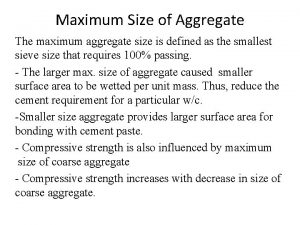Maximum Size of Aggregate The maximum aggregate size






- Slides: 6

Maximum Size of Aggregate The maximum aggregate size is defined as the smallest sieve size that requires 100% passing. - The larger max. size of aggregate caused smaller surface area to be wetted per unit mass. Thus, reduce the cement requirement for a particular w/c. -Smaller size aggregate provides larger surface area for bonding with cement paste. - Compressive strength is also influenced by maximum size of coarse aggregate - Compressive strength increases with decrease in size of coarse aggregate.

The maximum size of aggregate use in concrete is determined by: A-Thickness of concrete slab: the maximum size of aggregate is 1/3 -1/5 of slab thickness to get homogenizes distribution of concrete components. B-Spacing between reinforcement: the maximum size of aggregate is 3/4 clear space between reinforcement bars to make compaction of concrete looks better. C- Clear cover: the maximum size of aggregate should not be greater than 5 mm less than cover provided (If concrete cover is 30 mm, Max. size <25 mm). For Reinforced concrete works, maximum aggregate size of 20 mm is generally used.

Specific gravity (relative density) Sp. Gr: It is the ratio of the density of a material to the density of distilled water at a stated temperature. Most natural aggregates have specific gravity between 2. 4 and 2. 9 Sp. Gr. is used in certain computations for concrete mix design or control work, such as, absolute volume of aggregate in concrete. It is not a measure of the quality of aggregate.

Absolute specific gravity refers to the volume of the solid material excluding all pores (particles density only). Apparent specific gravity refers to the volume of solid material including the impermeable pores but not capillary pores (normally required in concrete technology).

Determination of Sp. Gr. of Aggregates (Archimedes Principle)

Coarse Aggregate 1 - Aggregate are oven dried at 105± 5°C overnight and the weight is measured as (A) 2 - Aggregate are soaked in water for 24 hours 3 - Aggregate are taken out from water and rolled in a large absorbent cloth, until all visible films of water are removed and then weighed (B) 4 -Aggregate are then weighed in water (C) Fine Aggregate. (https: //www. youtube. com/watch? v=l 6 vk 0 EM 4 y. Pg) 1 -Aggregate are oven dried to constant weight at 105± 5°C. Measure the dry weight as (D) 2 -Soak them in water for 24 hrs 3 -Stir the sample to bring it to SSD condition. Use the Cone Test for Surface Moisture Determination (Weight as A) 4 -Fill the aggregate in SSD condition into a pycnometer (to a calibrated level) and weight it, (water+pyconometer +agg) (B) 5 -Fill the pyconometer with water only (to a calibrated level) and weight it (water+pyconometer) (C)










